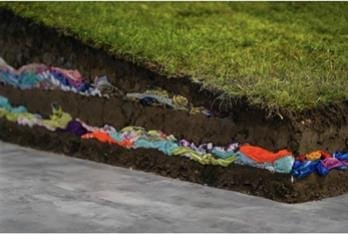Power in Every Thread: Maria A. Guzmán Capron and Minga Opazo
*Foto in evidenza: Maria A. Guzmán Capron, Me Veo en Ti, 2022. Fabric, thread, batting, stuffing, spray paint and acrylic paint, 56 x 60 1/2 in. Courtesy of the artist and Shulamit Nazarian
January 28 – May 5, 2024
Guest Curator: Alma Ruiz
Craft Contemporary
5814 Wilshire Blvd.,
Los Angeles, CA 90036
Power in Every Thread: Maria A. Guzmán Capron and Minga Opazo presents two artists, Maria A. Guzmán Capron and Minga Opazo, whose use of textiles unite them in an exhibition featuring a range of impressive two- and three-dimensional works. Minga’s work draws attention to environmental degradation caused by textile waste, while Maria’s aims to highlight awareness of multicultural identities, empowering those who step out of so-called societal norms. Both artists recycle fabrics, transforming them into unique forms of expression, rerouting their destination from the landfill to museums, galleries, or collector’s homes.
The artists work in “artivism,” a combination of art and activism that largely promotes social and environmental awareness. Infused with their unique experiences and backgrounds, the resulting pieces radiate powerful feminine energy. Although Minga is passionate about fashion as a form of human expression, she recognizes that its consumption fuels environmental and social inequality worldwide. As a result, she uses art to address this issue. What happens to clothing once it is no longer wearable? The answers vary, but in the end, there is so much that cannot be recycled, ending up in landfills or illegal dumps. Fashion’s dark side is unknown to many. Further, Maria uses colors, patterns, textures, and paint to create hand-crafted, vibrant pieces that reference class, gender, and cultural identity. Her hand- crafted works signal to people who have been treated as ‘other’ that they can make room for themselves. They recognize and celebrate individuals and communities marginalized by mainstream society.

Maria sources materials from thrift stores, discount fabric shops, and her own clothing to access the diverse range of cultures and aesthetics of commercial fabric production. Her tactile fabric figures,
collaged together, actively engage the viewer. She refers to them as “Hot Aliens” due to their ambiguous sexuality, origin, and hybrid human-animal appearance, as in Desátame (Untie Me), 2023. Maria’s “Hot Aliens” challenge gender binaries and reclaim the othering word “alien,” a dehumanizing term often used in the United States to refer to foreign-born individuals. In Maria’s oeuvre, “Hot Aliens” dance,
frolic, embrace, and hold hands with love and joy. Through their expressive gaze, they establish a connection with the viewer, a warm invitation to explore this multifaceted work.
Recent pieces extend from the wall into the space— like No Soy Florero – Mentira (I’m not a Vase – Lie), 2023, which features a woman’s form growing from a largely two-dimensional head and torso to a set of three-dimensional legs resting comfortably on the gallery floor. The telenovelas Maria first encountered while staying with an aunt inspired the piece. The female’s exaggerated expressions and appearance reflect the dramatic nature of this narrative form. The phrase “No soy florero” in the title is a rebuttal to her mother’s admonition “No eres florero” (“You Are Not a Vase”), often voiced to get Maria to be useful around the house and not just a decoration. “Mentira,” conveyed in the dramatic style used in telenovelas, expresses disbelief, meaning that she does not believe what her mother is saying. Maria’s fabric collages are vibrant, dynamic, and playful, reflecting her Latin American heritage and connection to underrepresented communities.

Minga Opazo expresses her passion for science through textile sculptures, some of which incorporate soil and grass, and a project using fungi to convert toxic textile waste into regenerative soil. Exploring solutions to excessive consumerism, she repurposes textiles that would otherwise end up in a landfill. After discovering microplastics in fossils found in Hawaii, Minga created Siempre más (Always More), 2023, in which layered fabrics formed into geode shapes present a new kind of geology that meditates on the insatiable consumer appetite for more. The Hawaiian brightly colored volcanic rocks may represent our future geology. Are we ready to accept it? And what will happen with the majority of textile waste we produce?
To answer this last question, Minga began a project she called Re-dress, 2021. Working closely with a scientist, she learned about the habitats in which fungi prosper. She began growing oyster mushrooms by feeding them textile waste. She found cultivating oyster mushrooms in synthetic textile containers filled with sawdust was possible. The white fuzz that developed is a root network known as mycelium.
The mycelium absorbs the nutrients, in this case, the sawdust, before feeding on the textiles. Minga felt encouraged as the oyster mushrooms grew, though their lifespan lasted less than a month. The exhibition features four fruiting bodies of fungi and three photographs depicting the requiredenvironment for cultivation. Minga’s art employs textiles, clay, grass, sawdust, synthetic textiles, and live organisms to create a visually elegant and minimal yet transformative experience.
Both artists were introduced to fashion at a young age. Maria was born in Milan, Italy, to Peruvian and Colombian parents. She grew up aware that Milan is a major fashion hub in Europe. Born in Santiago, Chile, Minga grew up spending time in her mother’s clothing store, where she developed a passion for fashion. As teenagers, Maria and Minga coincidentally both migrated to the United States and earned art degrees from American universities. While in graduate school, they solidified their interest in textiles as an art form. Maria and Minga share a sensibility and deep understanding of fabric as a medium and harness the power of this material to express their social and environmental concerns.
